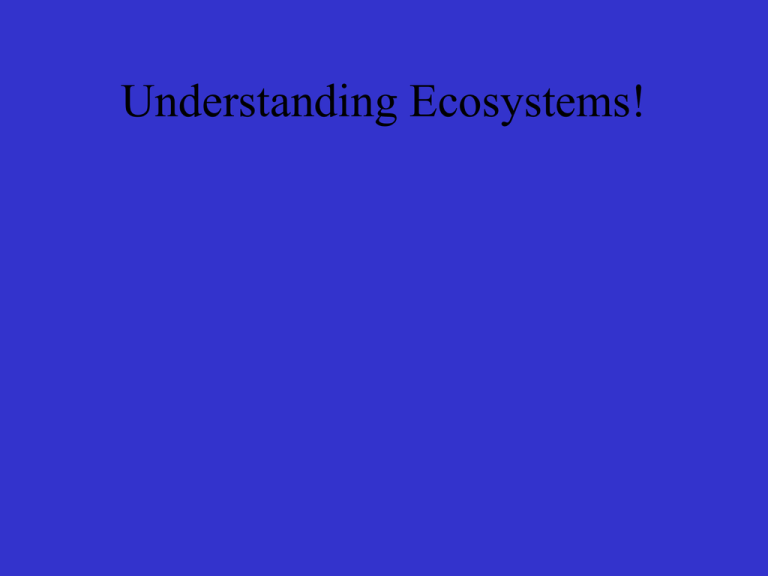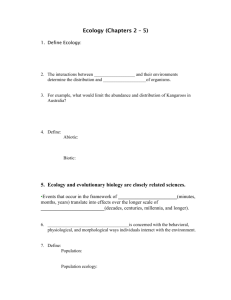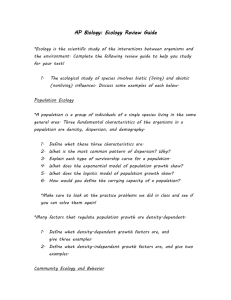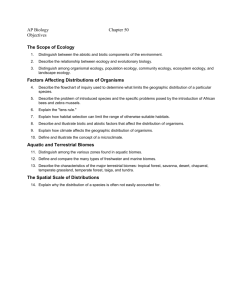PowerPoint
advertisement

Understanding Ecosystems! Common Core/ Next Generation Science Addressed MS‐LS2‐1.-Analyze and interpret data to provide evidence for the effects of resource availability on organisms and populations of organisms in an ecosystem. MS‐LS2‐3. - Develop a model to describe the cycling of matter and flow of energy among living and nonliving parts of an ecosystem. MS‐LS2‐4. - Construct an argument supported by empirical evidence that changes to physical or biological components of an ecosystem affect populations. MS‐LS2‐2. -Construct an explanation that predicts patterns of interactions among organisms across multiple ecosystems. MS‐LS2‐5.- Evaluate competing design solutions for maintaining biodiversity and ecosystem services. RST.6‐8.1-Cite specific textual evidence to support analysis of science and technical texts. (MS‐LS1‐6),(MS‐LS2‐1),(MS‐LS2‐4) RST.6‐8.7-Integrate quantitative or technical information expressed in words in a text with a version of that information expressed visually (e.g., in a flowchart, diagram, model, graph, or table). (MS‐LS2‐1) SL.8.5-Include multimedia components and visual displays in presentations to clarify claims and findings and emphasize salient points. (MS‐LS3‐1),(MS‐LS3‐2) Agriculture, Food and Natural Resources Addressed! • • NRS.01. Plan and conduct natural resource management activities that apply logical, reasoned and scientifically based solutions to natural resource issues and goals. • NRS.01.01. Apply methods of classification to examine natural resource availability and ecosystem function in a particular region. Sample Measurement: The following sample measurement strands are provided to guide the development of measurable activities, at different levels of proficiency, to assess students’ attainment of knowledge and skills related to this performance indicator. The topics represented by each strand are not all-encompassing. • – NRS.01.01.02.a. Summarize the components that comprise all ecosystems. Bell Work! • What type of environmental problems do we face here in New Mexico? • What type of forests are found in New Mexico? • Where would you find an ecosystem? Student Learning Objectives 1. Explain the role of ecology in the environment. 2. Describe community organization, structure, and food chains. 3. Describe natural selection and succession. 4. Explain homeostasis. 5. Identify population ecology and trends affecting population growth. 6. Identify and distinguish between biomes. Terms Biome Biosphere Carnivore Community Competition Decomposer Ecology Ecosystem Food chain Habitat Herbivore Homeostasis Natural selection Niche Omnivore Terms Population density Population ecology Predation Producer Succession Transformer Interest Approach If you were on a deserted island with only 10 pounds of corn and a dairy goat, what would you do? Would you eat the corn and the goat? Would you eat the goat and plant the corn? Would you plant some of the corn and feed the rest to the goat? Approach Two: Daily factors affect the relationship between the environment and living organisms. Ask students to identify some of the relationships. These relationships will be investigated in this lesson. Objective 1: Explain the role of ecology in the environment. What is the role of Ecology in the Environment? Ecology is the study of how living organisms exist in their environment. What is the role of Ecology in the Environment? A. Biosphere is the area of the earth that supports life. B. An Ecosystem is a self-contained living system. Forestry Supply Company What is the role of Ecology in the Environment? 1. The biotic portion of an ecosystem is living. 2. The abiotic portion is non-living. 3. The biotic portion relies on the abiotic portion. For example, plants, which are biotic, require soil nutrients, which are abiotic. 4. The biotic portion may rely on other biotic factors. For example, animals eat plants. Artwork supplied with permission of Interstate Publishers, Inc Objective Two Describe community organization, structure, and food chains. How does the Community Function? A Community is a collection of plants and animals that live together. Artwork supplied with permission of Interstate Publishers, Inc How does the Community Function? Habitat is the natural home of a plant or animal. 1. The interactions of biotic and abiotic factors form habitats. 2. Habitat may be terrestrial (land), aquatic (water), or a combination (wetland). 3. A change in a portion of the habitat affects all organisms present. How does the Community Function? A Niche is the special way of living that an organism has in a community. 1. It includes available food, shelter, way of life, and relationships. 2. Each organism makes unique contributions to its habitat. How does the Community Function? The Food chain is the sequence in which the living organisms in a community obtain their food. 1. Producers are plants that make food through photosynthesis. 2. Transformers are organisms that take in producers and synthesize more complex forms of food. 3. Decomposers are organisms that break down organic materials into their constituents for re-use by the environment. How does the Community Function? Feeding groups are segments of a food chain that consume certain types of food. 1. Herbivores are animals that eat only plants. 2. Carnivores are animals that eat only flesh of other animals. 3. Omnivores are animals that eat both plants and animals. Objective Three Describe natural selection and succession. What is Natural Selection and Succession? Organisms must adapt to changes in their environment to survive. What is Natural Selection and Succession? Natural selection is when life forms that are best adapted to their environment survive longer and leave more offspring. 1. Adaptation occurs when species tolerate changes in the environment. 2. Advantageous traits are emphasized in natural selection, i.e. more dominant features are passed on to offspring. What is Natural Selection and Succession? Succession is replacement of one community with another. 1. The species with the lowest biomass grow first. 2. Natural events or human interference control the speed of succession. Objective 4: Explain Homeostasis What is Homeostasis? • Homeostasis is the ability of an organism to maintain a fairly constant internal environment when the external environment changes. What is Homeostasis? B. The organism is affected by: 1. Climate 2. Moisture 3. Temperature 4. Light 5. Soil 6. Periodicity (when things occur in regular intervals) Objective 5 Identify population ecology and trends affecting population growth. What are population ecology and what trends affect population growth? Population ecology is the study of how populations of organisms affect each other in a community. What are population ecology and what trends affect population growth? Population ecology considers three primary factors. 1. Population density is the measure of how crowded organisms are in a community. A. A higher density means more competition for resources. B. Weaker individuals may not survive in areas of high population density. What are population ecology and what trends affect population growth? Population ecology considers three primary factors. (continued) 2. The age of a population is classified as: A. Pre-reproductive: young organisms not yet reproducing. B. Reproductive: age at which reproduction occurs. C. Post reproductive: past normal age of reproduction. What are population ecology and what trends affect population growth? Population ecology considers three primary factors. (continued) 3. Distribution describes the spatial relation between organisms in the community. A. Some organisms will cluster (i.e. squirrels around a tree). B. Some scattering is often needed (i.e. trees require space to grow). What are population ecology and what trends affect population growth? Population growth studies the natural trends in the population of a community. 1. Immigration: organisms move into a community. 2. Emigration: organisms move out of a community. 3. Natality: production of new individuals in a community. 4. Mortality: death rate of a community. What are population ecology and what trends affect population growth? Population growth studies the natural trends in the population of a community. (continued) 5. Competition: organisms share the same resources to live. A. Increased competition may stunt growth. B. Competition may be created by increasing population density. 6. Predation: one living organism serves as food for another. Objective 6 Identify and distinguish between biomes. How are biomes different? Biomes: are unique combinations of plants and animals. How are biomes different? A. There are five major terrestrial biomes. 1. Tropical forests are characterized by a warm, wet climate. 2. Temperate forests are common forests in the U.S. 3. Grasslands and savannas are areas where grasses normally grow. How are biomes different? A. There are five major terrestrial biomes(continued) 4. Tundra (low temperature and short growing season) and taiga (cold climate with conifer forests) represent minimal diversity. 5. Deserts support some plant and animals. How are biomes different? B. There are four major aquatic biomes that are dependent on water type and movement. 1. Lakes and ponds: provide a habitat for freshwater organisms. 2. Streams: vary by water temperature and water flow. How are biomes different? B. There are four major aquatic biomes that are dependent on water type and movement. (continued) 3. Oceans: provide a suitable habitat for organisms that would not survive in freshwater. 4. Wetlands: (i.e. swamps and marshes) and estuaries (saltwater or freshwater where streams flow into oceans) are land areas that are affected by water. Review / Summary • • • • What is Ecology? Identify the term community. How is a Niche and a Community alike and how are they different? Identify the correct term for animals that eat plants, animals that eat meat, and animals that eat both plants and meat. Review / Summary (continued) • • How are Biomes different? Identify the five major biomes. The End!







